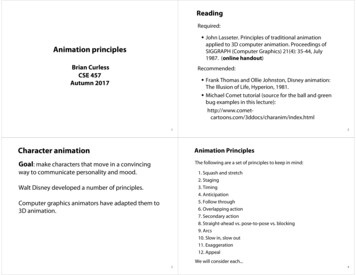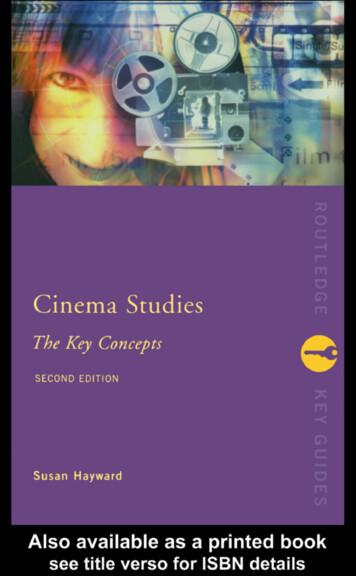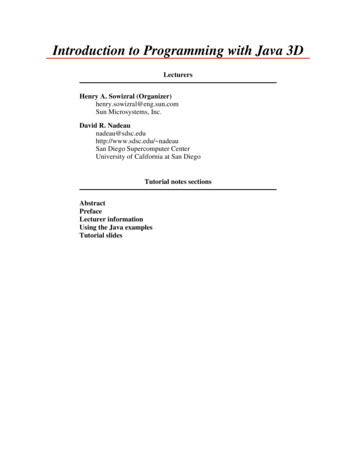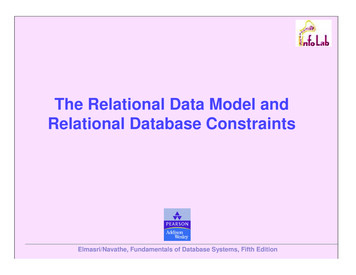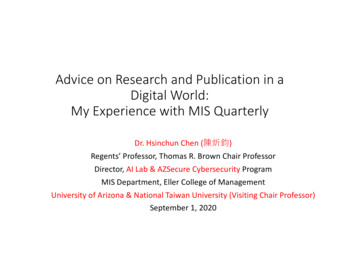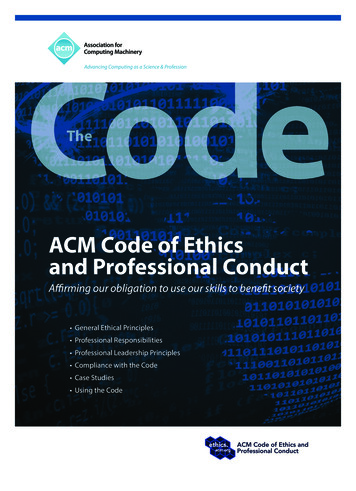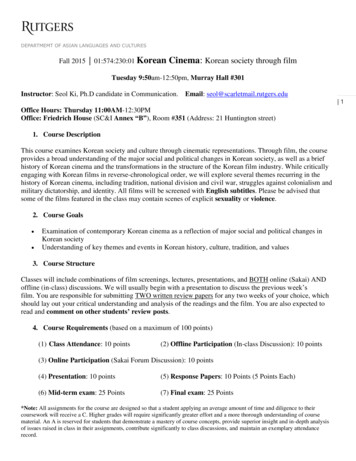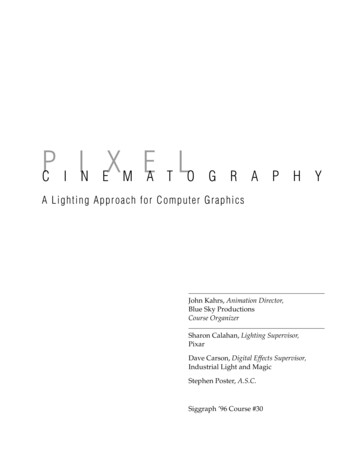
Transcription
PC I IN EX M EA T LOGRAPHA Li ght in g A p p r o ach fo r C om pu t e r G ra p h i c sJohn Kahrs, Animation Director,Blue Sky ProductionsCourse OrganizerSharon Calahan, Lighting Supervisor,PixarDave Carson, Digital Effects Supervisor,Industrial Light and MagicStephen Poster, A.S.C.Siggraph ’96 Course #30Y
T A B L EO FC O N T E N T SSchedule5Speaker Biographies7Course Introduction9Storytelling Through Lightingby Sharon Callahan11Lighting from a Filmmaker’s Perspectiveby Stephen Poster41Pixel CinematographyLighting for Computer Graphicsby John Kahrs43Lighting for Compositing and Integrationby Dave Carson69
4PIXELCINEMA TOGRAPHY
C O U R S ES C H E D U L E8:30 amIntroductionKahrs8:40 amLighting from aFilmmaker’s PerspectivePoster10:00 amBreak10:15 pmStorytelling Through LightingCalahan12:00 noon Break1:30 pmA Lighting Approach forComputer ImageryKahrs3:00 pmBreak3:15 pmLighting for Compositingand IntegrationCarsonPIXELCINEMATOGRAPHY5
6PIXELCINEMA TOGRAPHY
SB I PO EG AR AK PE H RIESSharon Calahan, Lighting SupervisorPixar Animation StudiosJohn Kahrs, Animation DirectorBlue Sky ProductionsAs the creative Lighting Supervisor for Pixar’s“Toy Story”, Sharon Calahan has been a member of the technical team at Pixar for the lasttwo years. Her background and education inart and design led her into advertising, broadcast TV, video production, and eventually computer animation. With a focus on lighting direction, Sharon has worked in computer animation for over ten years. Besides “Toy Story” andvarious commercial work, other accomplishments have been as the computer animationLighting Director for Hanna-Barbera’s “TheLast Halloween” which won an Emmy for Special Effects.John has been directing lighting and animationat Blue Sky Productions since 1990. The focus atBlue Sky has been on a classic approach tocharacter animation, combined with the verybest rendering techniques. At the core of theproduction system is a proprietary raytracer,for which John has written much of the user’smanual. John has made a priority of refiningBlue Sky’s lighting techniques. His lighting andanimation appears in several commercials forclients including Braun razors, Chock-full-O’Nuts coffee, and Brother laser printers. John designed and constructed the Blue Sky web site.He also has outlined the lighting direction forthe CG cockroaches in the upcoming featurefilm “Joe’s Apartment”. In 1993, John won aGolden Nica Award for his radiosity imagery atthe Ars Electronica festival in Linz, Austria.Dave Carson, Visual Effects SupervisorIndustrial Light & MagicDave Carson has been at ILM for over 15 years,beginning as a storyboard artist and modelmaker on the second and third Star Wars films.He has worked in various roles on many remarkable films, primarily as a Visual EffectsArt Director and Visual Effects Supervisor. Hiswork in the digital realm includes acting as aDigital Artist on “Hook”, “Forrest Gump” and“Jurassic Park”. He also contributed characterdesign and animation on “Casper” where hewas credited as Character Design Supervisor.His latest projects include supervising the updating of work in “Empire Strikes Back” and“Return of the Jedi” for their new film releases.He is currently scheduled to begin work as aVisual Effects Supervisor on the next film in theStar Wars series when it goes into productionlater this year.Steven Poster, A.S.C.,CinematographerStephen Poster has worked on dozens of films,including Ridley Scott’s “Someone To WatchOver Me”, “Big Top Pee-Wee” and most recently “Roswell,” about the reported crash of aUFO in New Mexico in 1947. Originally fromChicago, Poster was called upon early in hiscareer to shoot second unit photography on“Close Encounters of a Third Kind” and “BladeRunner”.PIXELCINEMATOGRAPHY7
8PIXELCINEMA TOGRAPHY
COURSEI N T R O D UHow do you “Teach” Lighting?Software tools and complex lighting models forcomputer graphics are some of the most elegant,sophisticated technologies of our time, yet theattention paid to lighting and refining the images is often minimal, and sometimes practicallynonexistent. Conversely, we also see subtle,beautiful, resonant images made with computers. What accounts for this disparity?An answer may lie in the fact that some computer artists have a deeper understanding oflight and material qualities, while others maynot even consider lighting as an issue. Theymay not have trained themselves to see and understand how light works, especially with theoften incomplete lighting model in computergraphics.This course focuses on the craft of lighting forcomputer graphics. Using a hybrid approach oftraditional cinematography and knowledgeabout composition, color, balance, and the behavior of light and materials, it offers a comprehensive approach for lighting specifically in thefield of computer graphics.I think the idea for a lighting course specificallyfor CG is very timely. It’s almost to the pointwhere it’s hard to find a sizeable Hollywoodfilm without some kind of digital effect of somesort. The medium of computer animation is, Ithink, entering a Golden age. Software toolsmore powerful than ever, and elegant in theirsophistication. A beautiful film called Toy Storyhas been embraced in and outside the graphicscommunity. To just watch the Siggraph filmshows from the past decade is to see technol-CTIONogy evolve into artistry. We hear a lot abouthow there’s no ceiling, there’s no end in sight,we’re only just beginning, and all this limitlessoptimism can get on your nerves after a while,but the funny thing is that it’s the truth.Part of what inspired the idea for a course onlighting is the animation courses at Siggraphthat seem to pop up every other year or so. Ihoped to do for CG lighting what JohnLasseter, Chris Wedge and others have done forcomputer animation. The influence of traditionally trained animators in the new medium reflected a sea change that was occurring in thelate eighties: those who used the classic principles of animation applied them when usingthe new tools. This mood culminated in a 1987Siggraph course: 3D Character Animation byComputer, and more recently, 1994’s AnimationTricks. Suddenly CG animation had grown up.The cliche of slow, computer-smooth motionbecame less prevalent. Now it was entertaining,exciting, and the entire medium was beingtaken more seriously. They succeeded becausetraditional techniques, hammered out overyears of practical use and distilled down to alist of basic principles, were skillfully appliedto a new medium.I hoped that a similar approach could be appliedto computer lighting: where the principles of traditional cinematography could be applied to thenew tools. This is possible, but only to a certainextent. This is partly because, while there aremany strong parallels, traditional techniquesaren’t so easily portable to computer techniques,as they are with animation.PIXELCINEMATOGRAPHY9
As I wrote the course notes for my part of thetalk, the idea of the course changed drastically.I had thought that the course speakers couldteach lighting, plain and simple. I reallythought, for some time, that in lighting too,much of the task could be distilled down to anessential list, and my ultimate model for such alist was “The Principles of Animation”, a chapter in the indispensable book, The Illusion of Life:Disney Animation, by Frank Thomas and OllieJohnston.cause the level of control can be so basic. Thereare so many different skills to be proficient inwhen we do this. We have to be Renaissancepeople.Then I was on the phone one day with StevenPoster, the cinematographer I asked to speak atthe course to offer a look at lighting from a traditional angle. He said out loud what I hadbeen sensing deep down more and moreclearly. He said, “Oh, absolutely, no. No, youcan’t teach lighting. You can’t teach someonehow to light. You can only teach them aboutlight and how it works, and you can give thema few guidelines, but you can’t teach anyonehow to light.”The artistry of computer lighting has to comefrom your own vision and intuition about whatyou want to see. If it succeeds, it may help yousee light in a way you hadn’t before, and encourage you to teach yourself how to createtruly great images.So how to approach the task of lighting on thecomputer John KahrsNew York, May 1996I realized my folly in presuming this. It waslike figure drawing class in art school. No onecould teach us how to draw. Only we, the students, could teach ourselves to draw better. Theinstructor was merely trying to get us to seemore clearly: to observe and measure with oureyes and compare what we saw with what wehad drawn. If the instructor was good, he wastrying to teach us to see.The process of computer graphics work is likeworking with a kind of complex diorama-machine. We’re creating little worlds, and we canbuild everything almost as if from scratch, be-10PIXELCINEMATOGRAPHThis course isn’t going to magically transformanyone’s images into flawlessly refined pictures. All it can really do is offer a few guidelines, provide some important things to remember, and hopefully point you in the right direction with a solid footing about where to start.Y
ST HT ROORUYG TH E LL LI GI NH GT IN GA Compu ter Gr ap h ics Pe rs p e c t i v eBy Sharon CalahanABSTRACTThis course is designed as a beginning, nontechnical course to discuss the how lighting incomputer graphics can be used to enhance visual storytelling for cinematic purposes. It collects knowledge and principles from the disciplines of design, fine art, photography, illustration, cinematography and the psychology ofvisual perception. Although much of the content of this course is not solely applicable tolighting on the computer, its special needs arealways in mind.1. IntroductionThe desire to write these notes and to present acourse on lighting for storytelling in computeranimation arose from the shortage of availableliterature on the subject. Frequently I am askedto recommend a book or two on lighting, and although several good books are available, noneare ideal. Most tend to focus on the equipmentand mechanics of live-action lighting withoutexplaining how to achieve the fundamentalprinciples. The commonality between live-actionlighting and computer lighting is chiefly thethought process, not the equipment. Computertools vary with implementation, are continuallyevolving, and are not limited by physics. Toolsin the future will be driven by the desire to seeon the screen what we are able to visualize inour minds. This course is designed to focus onthese thought processes, while providing notonly practical information, but also the desireand resources to continue exploring.The use of words alone is inadequate to describe visual concepts. Most books includemany repetitive visual examples to drive thepoint home. Although a few crude visual examples are included in these notes, they aremerely intended to serve as a reminder of thepresentation of this course. These notes are alsonecessarily succinct, and may contain conceptswhich could not fit into the hour-and-a-halftime allotment.The term lighting in computer animation oftenincludes the task of describing the surface characteristics of objects (often referred to asshaders), as well as compositing and the integration of special effects. For the purposes ofthis course, lighting is defined more in live-action terms as the design and placement of thelights themselves, but in a purely computergraphics environment.Visual storytelling is a vast topic that reaches farbeyond the realm of lighting. Most of it is notnoticeable on a conscious level to the viewer,but adds depth and richness to the story and thevisual experience. The lighting principles andtechniques presented in this course are discussed in isolation from other visual storytellingdevices. Ideally the lighting would be designedwith these in mind, but would extend far beyond the scope of this course.Cinematic lighting literature typically emphasizes live-action lighting issues and techniques,and in this discussion of lighting for syntheticcinema we will find that many live-action concepts apply. However, there are some differences in the approach, roles and responsibilities, the size of the crew, and the sequence inwhich tasks are accomplished.PIXELCINEMATOGRAPHY11
In live-action, the lighting design, the staging,and framing of a shot are a collaborative and simultaneous effort between the director and cinematographer. Each activity affects the other,and it is important that they are fine-tuned together. Actors can rehearse the scene, stagingand framing can be altered, and props can beredressed to take best advantage of the lightingdesign. This differs from the pipeline approachoften employed in synthetic cinema, where themodeling, surface design, staging, framing, setdressing, and acting are accomplished sequentially, each usually established before the lighting designer begins to work. It should be keptin mind that the sooner in the production process the lighting can be designed, the more involved it can be in the storytelling process.Another important difference between live-action and synthetic lighting can be the role of theart director. In live-action, the art director is absorbed in designing sets and props and is notusually involved in staging, framing, and lighting design. On the other hand, computer generated animation has a more stylized, illustrativequality, with its roots more in hand-drawn animation than live-action cinema. In addition todesigning sets and props, the art director is alsooften heavily involved in the staging (layout)and lighting decisions. With the director, the artdirector is often responsible for determiningthe lighting style for individual sequences aswell as the film as a whole.2. Objectives of LightingThe primary purpose of cinematic lighting isstorytelling. The director is the storyteller and itis his vision that the lighting designer is attempting to reveal. To that end, it is important to understand the story-point behind each shot, andhow it relates to the story as a whole. It is notenough that the lighting designer simply illuminate the scene so the viewer can see what is happening, or to make it look pretty. It is the light12PIXELCINEMATOGRAPHYing designer’s task to captivate the audience byemphasizing the action and setting the mood.The following six lighting objectives are important fundamentals of good lighting design.They also break down the thought process intoa good course outline. They are borrowed andadapted from the book Matters of Light andDepth, by Ross Lowell. Directing the viewer’s eye Enhancing mood, atmosphere and drama Creating depth Conveying time of day and season Revealing character personality and situation Complementing composition3. Directing the Viewer’s Eye—The Study of CompositionThe primary objective of good lighting is toshow the viewer where to look. Shots are oftenon-screen only briefly, which means thestorytelling effectiveness of a shot often depends upon how well, and how quickly, theviewer’s eye is led to the key story elements.Learning to direct the viewer ’s eye is essentially the study of composition. Composition is aterm which is used to collectively describe agroup of related visual principles. These principles are the criterion employed to evaluatethe effectiveness of an image. They are notrules to be followed, but define a structure bywhich to explore creative possibilities. They describe a visual vocabulary, and provide methods for breaking down a complex image intomanageable characteristics for subjective analysis. Besides being of interest to artists, theseprinciples are also an important aspect of visualperception and cognitive psychology research.The seemingly simple act of placing lights canradically change the composition and focal pointof a shot. Good lighting can make a well-com-
posed image stunning. It can also help rescue aless-than-perfect composition. The principles ofcomposition are the tools with which the lighting designer can analyze a scene to devise waysto accentuate what is working and to minimize what is not. They are effective in bothstatic or moving scenes. Pauses in cameramoves and character poses are perfect opportunities to evaluate a kinetic composition using static techniques.Rather than simply referring the reader atthis point to consult a book on composition, a brief discussion of the primaryprinciples needed to the lighting designerare presented here. Although each principle relates to the others, they are presented inisolation for clarity.3.1 Unity/HarmonyThe name of this principle suggests that theelements of the composition appear to belongtogether, relate to each other, and to otherwisevisually agree. Where other principles of composition break down the image into specific topics for study, the principle of unityreminds the artist to take a step back andlook at the image as a whole.Although most artists rely on intuition todecide if a composition is working, thecognitive psychologists offer a somewhatless subjective alternative. They study theeye and brain processes that lead to theartist’s intuitive decisions. The cognitivepsychologists have developed the Gestalttheory to help explain our perceptual tendencies. The term Gestalt means “whole” or “pattern.” Gestaltists emphasize the importance oforganization and patterning in enabling theviewer to perceive the whole stimulus ratherthan discerning it only as discrete parts. Theypropose a set of laws of organization that reflect how people perceive form. Without theseorganizational rules, our world would be visually overwhelming. They include: The brain tends to group objects that are closeto each other into a larger unit. This is especially true with objects which share properties such as size, shape, color or value. Negative or empty spaces will likewise beorganized and grouped. Elements are divided into planes, such asforeground and background planes. Patterns or objects that continue in one direction, even if interrupted by another pattern,are perceived as being continuous. The brainwants to perceive a finished or whole uniteven if there are gaps in it. The brain attempts to interpret the world byfinding constancies. If a person is familiarwith an object, he remembers its size, shapeand color and applies that memory when hesees that object in an unfamiliar environment. This helps him to become familiarwith the new environment, instead of becoming disoriented, by relating the objects inthe new environment to the known object.PIXELCINEMATOGRAPHY13
By ignoring these principles, an artist risks creating an image which challenges the eye to organize it with little success. The viewer’s eyewill quickly tire and lose interest. Conversely,too much unity can be boring; if there is nothing to visually resolve, the eye will also quicklylose interest.By understanding how the eye tends to groupobjects together, the lighting designer canhelp unify a disorganized or busy compositionwith careful shadow placement, or by minimizing or emphasizing certain elements with lightand color.3.2 EmphasisTo direct the viewer ’s eye, an image needs apoint of emphasis, or focal point. An imagewithout emphasis is like wallpaper, the eyehas no particular place to look and no rewardfor having tried. Images which are lit with default or uniform lighting similarly feel draband lifeless. By establishing the quantity,placement and intensities of focal points, thelighting designer directs the attention of theviewer by giving him something interesting tolook at, but without overwhelming the viewerwith too much of a good thing.A composition may have more than one focalpoint, but one should dominate. The more complicated an image is, the more necessary pointsof emphasis are to help organize the elements.Introducing a focal point is not difficult, but itshould be created with some subtlety and asense of restraint. It must remain a part of theoverall design.By first understanding what attracts the eye,the lighting designer can then devise methodsto minimize areas which distract the viewerby commanding unwanted attention, and instead create more emphasis in areas whichshould be getting the viewer’s attention.14PIXELCINEMATOGRAPHY3.2.1 Emphasis Through ContrastsThe primary method for achieving emphasis isby establishing contrast. Contrast can beachieved with shape, size, color, texture, brightness or even motion. A focal point results whenone element differs significantly from other elements. This difference interrupts the overall feeling or pattern, which automatically attracts theeye. With one dark dot among thirty bright ones,there is no question which dot gets noticed, thedark one, for two reasons: it has the most contrastwith its background, but also because it is theonly one of its type. Unique or minority elementswithin larger groups tend to attract our attention.Contrast in value (brightness) is easy for the eyeto see, which is why black and white imagery issuccessful despite its lack of color. It also illustrates why lighting is a major tool in the establishment of emphasis and directing the eye ofthe viewer.3.2.2 Emphasis Through TangentsTangents, where two edges just touch eachother, can produce a strong point of emphasis
by creating visual tension. The eye is not comfortable with tangent edges and wants tomove them apart. With care, tangents can becreated intentionally to attract viewer interest;however, most of the time they are accidentaland distracting. If a tangent is creating unwanted emphasis, it is best to try to move oneof the shapes. It may be necessary to move anobject in the scene if it falls tangent to anotherobject. Another potential compositional problem is when an edge of a shadow or light fallstangent with an object or other geometricedge. In this case, it is preferable to move theshadow or light to avoid the tangency.3.2.3 Emphasis Through IsolationEmphasis by isolation is a variation of the Gestalt grouping concept. When an object defiesgrouping, by not being near or similar to anyother object, it calls attention to itself and becomes a point of emphasis through tension.This tension is created by the feeling ofunpredictability caused by the lone element notbelonging to the group.3.2.4 Emphasis Through AnglesA subtle form of emphasis can be achieved byusing perspective angles and other edgeswhich lead the eye to the focal point. However,they can just as easily lead the eye away fromthe intended subject. If perspective angles areleading the eye away from the focal point, it isnecessary to attract or contain the eye morestrongly using another method.3.2.5 Emphasis Through ShapeThe brain tends to characterize shape as eitherrectilinear or curvilinear. Most images are notcomprised of strictly one or the other. By creating an image with primarily one type, theother type becomes a point of emphasis. Inthe simple example to the right, the trianglestands out from the field of circles because ofits shape is unusual in this context.As another example, a long straight shadowin an image with a lot of curves may need tohave less contrast or a softer edge than usualto keep it from drawing too much attention. Abusy shape among many simple ones, or viceversa, will also attract attention. This conceptIf this emphasis is undesirable, finding a wayto link it to the larger group may help minimize attention. Using an edge of a shadow topoint to the isolated element is one way tolink it to the group.PIXELCINEMATOGRAPHY15
may be helpful in recognizing why an objectmight be attracting more attention than otherwise expected.3.2.6 Emphasis Through RecognitionBecause of the human need for self-recognition,human or anthropomorphic characters willnaturally attract more attention than inanimateobjects. Furthermore, in our attempt to recognize a character, we naturally are attracted tolook at his face, and especially to his eyes if he isspeaking, to see what he is thinking and feeling.3.2.7 Emphasis Through MotionA static image has static points of emphasis andall principles of emphasis apply, but a movingimage has the added bonus of being able to create emphasis through motion. Camera motionand character acting are topics unto themselves(see [Lasseter87]), but it helps to understandwhen the eye is attracted to moving objects andwhen it is not. If all objects are moving exceptone, the eye will be drawn to the one which isnot moving. The opposite case, of only one object moving, is more common and even moreeffective in attracting attention.3.3 BalanceWhen an object is unbalanced, it looks as thoughit will topple over. Instinctively the viewerwants to place it upright or straighten it. An unbalanced object is distracting and calls attentionto itself. An entire image which is off-balancewill make the viewer uncomfortable because hewants to balance it, but cannot. This discomfortcan be desirable if it enhances the mood orstorypoint. By knowing ways to balance or intentionally unbalance an image, the lighting designer can affect the mood of the scene.A scale is balanced by putting equal weight onboth sides. It doesn’t matter how large or densethe objects placed on the scale are, they will bal-16PIXELCINEMATOGRAPHYance as long as they have equal weight. The balancing of a composition is similar except that visual interest becomes the unit of measure. Visualinterest comes in many shapes, sizes, values, colors and textures, each with varying density. Theprinciples of emphasis and balance are thereforerelated since points of emphasis carry visualweight which must be considered when evaluating the balance of an image.Visual balance is achieved using two equations.The first balances the image around a horizontal axis, where the two halves, top and bottom,should achieve a sense of equilibrium. Although it is desirable to have a sense of equaldistribution, because of gravity, the viewer isaccustomed to this horizontal axis being placedlower than the middle of the frame.Besides helping to create a pleasing image, thetop/bottom weight ratio can also have astorytelling effect. The majority of constant factors in our visual life experience tend to behorizontal in nature—the groundplane beneathour feet, the horizon in the distance, the surfaces of water. Where these horizontal divisionsare, relative to where we are, tells us how tallwe are, how far off the ground we might be, orwhether we might bump our heads on something. Because we are accustomed to makingthese comparisons, the placement of a characterwithin the image format and the angle that thecamera sees him can imply the height of a character. And since we tend to associate height as adominating physical characteristic, it can saysomething about the importance of the character in his current situation. In one shot a shortcharacter is placed high in the frame, in thenext shot a tall character is placed lower in theframe. The shorter character in the first shotfeels taller and more important to us than thecharacter who is actually taller but is visuallysubservient. A character’s eyes are usuallyplaced above the center line, unless the character is looking up.
The second equation of visual balance dividesthe image around a central vertical axis. Thehorizontal format of cinema is most affected bythis left/right ratio. And with the possibilitiesof action entering and exiting the frame, orcamera pans and dollies, this ratio has the potential to be very dynamic.The simplest type of left/right balance is symmetrical balance, where the two sides are mirror images of each other. Symmetrical balanceis discussed here primarily because it is easyto understand and to achieve. Heavily used inarchitecture, symmetrical balance feels veryformal, permanent, strong, calm and stable. Inother forms of art, perfect symmetry is rarelyseen. One distinct advantage of symmetry isthe immediate creation and emphasis of a focal point. With two similar sides, there is an obvious visual importance to whatever element isplaced on the center axis. Another asset is itsability to easily organize busy, complex elements into a coherent whole. In film, symmetrical balance is sometimes used to help portray aformal, official, or religious environment ormood. The Ingmar Bergman film “WinterLight” uses symmetrical balance to impart stiff,claustrophobic formality to the church settingin the opening sequence.In contrast to symmetrical balance, asymmetricalbalance is more commonly used, more naturalin feeling, and much more challenging toachieve. Although asymmetry appears morecasual and less planned than symmetry, its visual ease belies the difficulty in its creation.Balance must be achieved with dissimilar elements by manipulating the visual interest ofeach. Some of the variables to manipulate arevalue, color, shape, texture, position and eyedirection. Each are discussed here individuallyfor clarity, but keep in mind that the interplayof these variables will affect the end result.Color can balance value, or texture can balance shape, infinite combinations are possible.3.3.1 Balance by ValueWe have already discussed that the eye is attracted to contrasts, particularly that a high contrast area attracts more interest than one of lowcontrast. To balance the scale, a small area ofhigh contrast will command an equal amount ofattention as a large, low contrast area.When it comes to projecting film in a theatre,the value scale isn’t necessarily level to beginwith. A theatre is dark to draw the viewers attention to the screen. In general, the eye is attracted to bright areas more than it is darkones, and in a dark theatre, with our pupils dilated, a bright area will attract even more attention since it contrasts with the darkness of thetheatre environment itself.3.3.2 Balance by ColorLike value, color can be a balancing element.The eye is more attracted to a color than to aneutral image, the more saturated the color, themore attention it grabs. A small area of brightPIXELC
computer animation. The influence of tradition-ally trained animators in the new medium re-flected a sea change that was occurring in the late eighties: those who used the classic prin-ciples of animation applied them when using the new tools. This mood culminated in a 1987 Siggraph course: 3D Character Animation by
